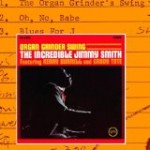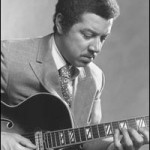How do we create a fantastic solo in just 32-bars? One that builds with each passing bar, while at the same time connecting phrases so seamlessly you’d swear someone was telling you a great story? I believe I found the answers in Kenny Burrell’s one chorus solo over “Satin Doll.”
Jimmy Smith recorded with many fine guitarist including Quentin Warren, Eddie McFadden, and even Grant Green and Wes Montgomery in his classic Hard Bop Organ Trios and all are swinging sessions. For me, I was always drawn to the albums with guitarist Kenny Burrell. Kenny recorded “Satin Doll” with organist Jimmy Smith on the album Organ Grinder Swing, on Verve records in June 1965. This side was one that stood out for me from the moment I heard it.
Kenny Burrell was born into a musical family in Detroit, MI in 1931 and began playing guitar in his early teens. He graduated from Wayne State University with a BA in Music Composition and Theory. Kenny was one of many great jazz artists to come out of Detroit in the 1950’s including Tommy Flanagan, Paul Chambers, and the Jones brothers, Hank, Thad, and Elvin.
In 1957 Kenny began to work with Jimmy Smith on and off and can be found on some of Jimmy’s most classic Blue Note albums including Midnight Special, Back At The Chicken Shack, and The Sermon.
I was turned on to this solo while in undergrad and was asked to transcribe it for an assignment, but I don’t know if truly understood what Kenny had done until recently. After listening to it (and transcribing it again) recently I was able to finally hear how coherent this one chorus was and how beautifully he built it from beginning to end.
There are so many great aspect of this solo. Kenny’s sense of time and swing is completely in the pocket. He has a natural gift of blending elements of the blues with bebop vocabulary. In Kenny’s one chorus (Jimmy gets five), he builds that perfect arc in his solo, steadily rising to a climax over half-way through, and coming back down slightly to let Jimmy have room to build as well.
It is hard to identify one single lick that stands out because each phrase appears to be connected to either the phase before or the phrase after. Kenny has constructed a solo of phrases that speak to each other in several call and response moments in both contour of the melody and relationship of pitch. There are times I almost hear a conversation taking place between two people.
Kenny begins with a wonderful melody outlining a C triad over the Dm7-G7 progression in which he resolves with a nice 7-3 (D-C#), with that jump up to A to finish the thought he began with in measure 4 over the Em-A7. In measure 1, his first phrase begins and ends on C. At measure 4 he ends on C# at the end of measure 3 into 4. This simple half-step relationship, to me, seems very vocal and conversational.
In measure 5, over the Am7-D7, Kenny descends chromatically from the A to the F# (3rd of D7) and arpeggiates up an F#m7(b5) chord to outline the 3rd, 5th, b7th, and 9th of the chord. He then uses the G and E to enclose the F on beat 1 of measure 6. The Abm7-Db7 progress is a tritone substitution for the typical ii-V progression (Dm7-G7) that would resolve to CMaj7. Kenny outlines the Db7 before brilliantly resolving into the D (9th) of CMaj7 on measure 7.

He begins the second A section with a scalar run up in triplets. Measures 11 and 12 seem to be response to the call made in measures 9 and 10. On beat one of measure 10, the highest note is G and ends on an A. In measure 11, he answers with phrase with a similar phrase with the highest note an A and lowest a G.
Both phrase contain a similar contour in shape and both utilize the triplet rhythm as the notes rise and then fall in the melody. But that relationship between these notes high and low note, help strengthen the question and answer theme Kenny continues to use.
![]()
He ends the section by adding one of Kenny’s signature blues flavor riffs to the Ellington standard using a C minor pentatonic run in measure 14.
The B section begins with another wonderful 4 bar call and response style melody in measures 17-20. Again, the relationship between the notes in these phrase are interesting. He opens with a simple C to A in m. 17, repeats them in 18, and then ends the phrase in m. 20 with C to A an octave lower. It is a simple thing, repeating two notes, but makes a strong impact on the coherency of the phrase.
In measures 21 and 22, he plays another simple call and response, this time a 4-note motive. Both share similar contour in shape and note relationship. The highest note in the first phrase is a D and lowest an E in m. 21. In m. 22 the highest is C and ends on an F#. Call and response is only a step a way.
For me, the climax is in measures 23 and 24 with the 16th note melody leading to the final A. The lick is a scalar run primarily focused on the G Mixolydian scale. I also notice that he ends the lick on a G. When looking the entire phrase from mm. 21 to 24, Kenny has a little motive just with the end notes of E, F#, and G that aurally seem to bind the four measures together.
Kenny kicks off the final A section with melodies that both outline the ii-V progressions and are strongly related to each other in texture. Notice the end notes in mm. 25 (D) and 26 (C#), a half-step relationship.
By measures 29 to the end he returns to the blues with some tasty C minor pentatonic based riffs to close out his chorus.

“Satin Doll” is a solo in which standard notation does not show what Kenny Burrell is doing justice. He has a unique way of pulling the notes to coincide with the emotion of the line. Slightly behind at times, dead center at others. His choice of notes that he will slide into with a glissando is also worth to note. He does not do it on every note, but he will gliss or slide at least once in each phrase. It is these subtle varieties in pitch that transform the solo from notes being played to a story being sung. These are traits and traditions in jazz performance that one cannot get without immersing your ears in the sounds. Kenny Burrell used his his guitar as his voice, a personal extension of himself, to crafted 32 bars of music that has a purpose and direction. That purpose is to say something meaningful and the direction is up.
Satin Doll PDF copy



What a great post. Going to study yoiur transcription. Thanx!!
Thank you Francesco, so glad you enjoy it. Happy shedding.